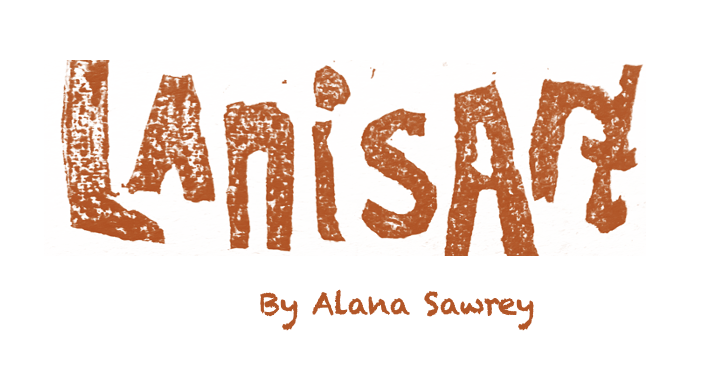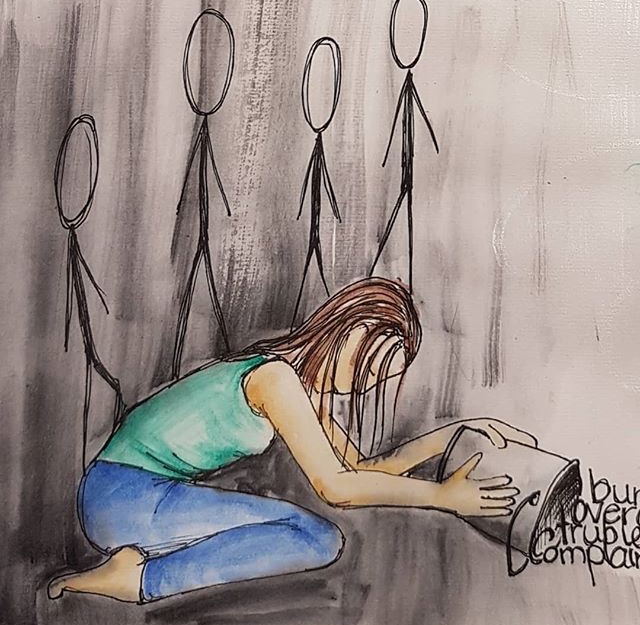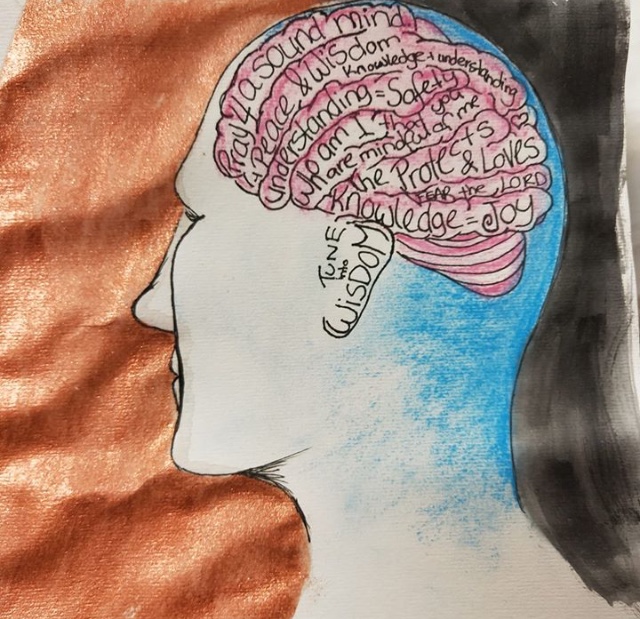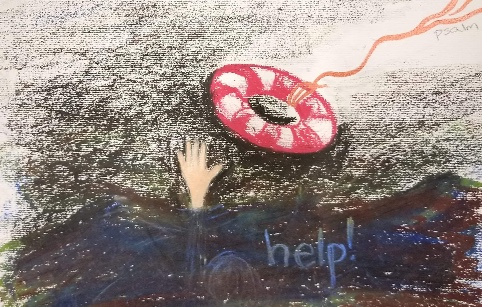Here goes:
January
‘Buildings To Live In’
Dr-Seuss inspired; this was an artwork created for an interactive art workshop used with primary school children- they made buildings that vaguely looked like the letters of their names.
February
‘Obscurity’
Inspired by my studies in art therapy. In the field of art therapy there’s an idea that “dialoguing” with an image (with an art therapist) can be a therapeutic process of learning and uncovering deeper meanings… to apply the principle to this drawing I’ve done I would ask the girl: who are you? Are you me? Why are you hiding? What are you holding? Where are you standing? What are you thinking? Giving the image a voice can reveal so much about yourself that you hadn’t even considered. I wonder if I was feeling a bit uncertain or clouded when I made this. I’m not sure yet.
March
‘Girl’s Search For Meaning’
The title was borrowed from a brilliant book I re-read in 2018 called ‘Man’s Search For Meaning’ which deals with the horrors of the second world war and concentration camps, and Viktor Frankl’s conclusions and observations about suffering, the nature of humankind, and meaning making. It’s a short book, told as experiences. The other part of this drawing is general appreciation for reading and storytelling. And our universal quest for meaning in our lives.
April
‘The Mysterious Quest For New’
I was totally hitting a creative wall when I drew this. Always using the same art medium, always dealing with roughly similar subject matter. I was pretty ready for some sort of new, and fyi I did find it- I got into watercolours after this.
May
‘Cut Me Loose, Set Me Free’
The abstract concept behind this image is that getting overly attached to ideas of others or future plans, or romanticising things you’d like to happen doesn’t generally end well. In this particular instance having my heart strings ‘cut free’ was a really hard and also really necessary experience. I hated it, and I’m glad it happened.
June
‘A Pocket Full of Passionfruits’
The story behind this is my favourite. This writing was inspired when I invited myself to my grandparents place for dinner and at the end of the night, my grandad (who by the way is the most generous person I know) loaded up my jacket pockets with passionfruits he'd been given. It set off a spark in me thinking about all the ways we communicate that we love someone (and how we receive it back).
July
‘Illumination’
This was born from a research project I was completing for uni. It was a heuristic study (which means my body of artwork was at the centre of the study) and part of this style of research is called ‘illumination’ where ideas kind of spark off and it gets exciting.
August
‘Bureaucrats’
All I am going to say is I am not particularly appreciative of bureaucratic red tape that seems to make things much harder than they need to be.
September
‘The Window Family’
This was the subject of an art workshop with children where they created quite abstract characters that were based off my characters. What I found cool is that children were most interested in projecting their own ideas about roles and relationships onto my window family; I loved observing this. I thought I had left them fairly vague, I mean after all they have windows for heads, but apparently children knew straight away exactly who was who and what was going on in the drawing.
October
‘Marine Stadium’
The short description is I was trying to sketch designs suitable for printing onto fabric, and I was drawing this while I was on a boat trip with my family at Marine Stadium. It was super nice.
November
‘New Zealand’
I got to explore NZ on a road trip with some friends in 2018 and I really liked how quick and fun watercolours were. Something different. These were: Arthur’s Point, Queenstown, and a loft we stayed in at Burke’s Pass.
December
‘Recurring Archetypes’
This image is based on a research project for uni, similar to the theme of the July artwork. This image contains important characters from my body of artwork from the last 6 years- many of these little characters popped up heaps in my artworks for years before I even thought to ask who or what they were. These are dear to me, and represent things most important, including: the lightbulb being Jesus (light, and illuminating truth in my life) the little stick man being the Holy Spirit (I call him the maintenance man; he is always working in the background of my drawings/life), and the Heart and Brain characters who are always at odds and learning to get along. I cried while I was drawing this because I felt conflicted about examining them in my research project; like maybe they wanted to stay more hidden. But I love sharing them. The art making process reveals so much about us, and I love that.
So there you have it! 12 artworks and 12 rambling explanations for you! I hope if you have the calendar, you very much enjoy it this year, and if you don’t yet, you’re in luck! Seeing as it is already January and I happen to have a couple leftover, they are now on sale! Here :)
I am leaving Aus for awhile on January 10, so get your orders in before then. My online store will closed after that for a short time.
Peace.




























